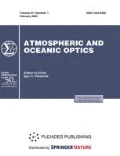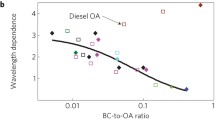Abstract
AERONET data are used to analyze variations in aerosol radiative characteristics caused by variations in the content of brown and black carbons in smogs of megacities by the example of Beijing, São Paulo, Santiago, and Mexico City. It is shown that the contribution of brown carbon to the imaginary part of refractive index at a wavelength of 440 nm in smogs can exceed the contribution of black carbon by a factor of three. In megacity smogs the spectral dependences of the aerosol absorption optical depth can be approximated by power-law functions with satisfactory accuracy, except in certain Beijing smogs at a wavelength of 400 nm for large relative concentrations of brown carbon. It is shown that the contribution of the coarse aerosol fraction to the total aerosol extinction optical depth in megacity smogs can be from 6 to 20% for wavelengths of 440 and 1020 nm, respectively, and that the contribution to aerosol absorption optical depth can be from 22% for a wavelength of 440 nm to 38% for a wavelength of 1020 nm. The aerosol in megacity smogs differs from the smoke aerosol from large-scale fires in the boreal forests of Russia by increased contribution of the coarse aerosol fraction to the total aerosol volume and by a relatively large imaginary part of the refractive index, and, hence, by a larger absorptance.
Similar content being viewed by others
References
Y. Feng, V. Ramanthan, and V. R. Katamarthi, “Brown carbon: A significant atmospheric absorber of solar radiation?,” Atmos. Chem. Phys. 13 (17), 8607–8621 (2013).
B. N. Holben, T. F. Eck, I. Slutsker, D. Tanre, I. P. Buis, A. Setzer, E. Vermote, J. A. Reagan, Y. J. Kaufman, N. Nakajima, F. Lavenu, L. Jakowiak, and A. Smirnov, “AERONET—a federated instrument network and data archive for aerosol characterization,” Remote Sens. Env. 66 (1), 1–16 (1998).
G. I. Gorchakov, S. A. Sitnov, M. A. Sviridenkov, E. G. Semoutnikova, A. S. Emilenko, A. A. Isakov, V. M. Kopeikin, A. V. Karpov, I. A. Gorchakova, K. S. Verichev, G. A. Kurbatov, and T. Ya. Ponomareva, “Satellite and ground-based monitoring of smoke in the atmosphere during the summer wildfires in European Russia in 2010 and Siberia in 2012,” Int. J. Remote Sens. 35 (15), 5698–5721 (2014).
V. S. Kozlov, E. P. Yausheva, S. A. Terpugova, M. V. Panchenko, D. G. Chernov, and V. P. Shmargunov, “Optical-microphysical properties of smoke haze from Siberian forest fires in summer 2012,”, Int. J. Remote Sens. 35 (15), 5722–5741 (2014).
G. S. Golitsyn, G. I. Gorchakov, E. I. Grechko, E. G. Semutnikova, V. S. Rakitin, E. V. Fokeeva, A. V. Karpov, G. A. Kurbatov, E. S. Baikova, and T. P. Safrygina, “Extreme carbon monoxide pollution of the atmospheric boundary layer in Moscow region in the summer of 2010,” Dokl. Earth Sci. 441 (2), 1666–1672 (2011).
G. S. Golitsyn, A. Kh. Shukurov, A. S. Ginzburg, A. G. Sutugin, and A. V. Andronova, “Complex study of optical microphysical properties of smoke aerosol,” Izv. Akad. Nauk, Fiz. Atmos. Okeana 24 (3), 227–234 (1988).
I. I. Mokhov, “Specific features of the 2010 summer heat formation in the European territory of Russia in the context of general climate changes and climate anomalies,” Izv., Atmos. Ocean. Phys. 47 (6), 653–660 (2011).
I. A. Gorchakova and I. I. Mokhov, “The radiative and thermal effects of smoke aerosol over the region of Moscow during the summer fires of 2010,” Izv., Atmos. Ocean. Phys. 48 (5), 496–503 (2012).
V. G. Bondur, “Space monitoring of wild fires in Russia under extreme hot in 2010,” Issled. Zemli Kosmosa, No. 3, 3–13 (2011).
V. G. Bondur, “Space monitoring of emission of trace gases and aerosols in wild fires in Russia,” Issled. Zemli Kosmosa, No. 6, 21–25 (2015).
N. Chubarova, E. Nezval, M. Sviridenkov, A. Smirnov, and I. Slutsker, “Smoke aerosol and its radiative effects during extreme fire event over Central Russia in summer 2010,” Atmos. Measur. Technol. 5 (3), 557–568 (2012).
N. F. Elanskii, I. I. Mokhov, I. B. Belikov, E. V. Berezina, A. S. Elokhov, V. A. Ivanov, N. V. Pankratova, O. V. Postylyakov, A. N. Safronov, A. I. Skorokhod, and R. A. Shumskii, “Gaseous admixtures in the atmosphere over Moscow during the 2010 summer,” Izv., Atmos. Ocean. Phys. 47 (6), 729–738 (2011).
I. N. Kuznetsova, A. M. Zvyagintsev, and E. G. Semutnikova, Environmental Consequences of Weather Anomalies in Summer 2010, The Analysis of Abnormal Weather Conditions in Summer 2010 (Priroda, Moscow, 2010), p. 58–64 [in Russian].
S. A. Sitnov, G. I. Gorchakov, M. A. Sviridenkov, V. M. Kopeikin, T. Ya. Ponomareva, and A. V. Karpov, “The effect of atmospheric circulation on the evolution and radiative forcing of smoke aerosol in European Russian in summer 2010,” Issled. Zemli Kosmosa, No. 2, 28–41 (2013).
G. I. Gorchakov, M. A. Sviridenkov, E. G. Semoutnikova, N. E. Chubarova, B. N. Kholben, A. V. Smirnov, A. S. Emilenko, A. A. Isakov, V. M. Kopeikin, A. V. Karpov, E. A. Lezina, and O. S. Zadorozhnaya, “Optical and microphysical parameters of the aerosol in the smoky atmosphere of the Moscow region in 2010,” Dokl. Earth. Sci. 437 (2), 513–517 (2011).
N. V. Dudorova and B. D. Belan, “Estimation of factors determining formation of the urban heat island in Tomsk,” Opt. Atmos. Okeana 29 (5), 426–436 (2016).
M. V. Panchenko, T. B. Zhuravleva, V. S. Kozlov, I. M. Nasrtdinov, V. V. Pol’kin, S. A. Terpugova, and D. G. Chernov, “Estimation of aerosol radiation effects under background and smoke-haze atmospheric conditions over Siberia from empirical data,” Rus. Meteorol. Hydrol. 41 (2), 104–111 (2016).
T. K. Sklyadneva, G. A. Ivlev, B. D. Belan, M. Yu. Arshinov, and D. V. Simonenkov, “The radiation regime of Tomsk in conditions of a smoky haze,” Opt. Atmos. Okeana 28 (3), 215–222 (2015).
T. F. Eck, B. N. Holben, J. S. Reid, A. Sinyk, E. J. Hyer, N. T. O' Neil, G. E. Shaw, J. R. Vandle Castle, F. S. Chapin, O. Dubovick, A. Smirnov, E. Vermote, J. S. Schafer, D. Giles, I. Slutsker, M. Sorokine, and W. W. New-Comb, “Optical properties of boreal region biomass burning aerosols in Central Alaska and seasonal variation of aerosol optical depth at an Arctic coastal site,” J. Geophys. Res. 114, D11201, 14 (2009).
V. E. Zuev and G. M. Krekov, Optical Models of the Atmosphere (Gidrometeoizdat, Leningrad, 1986) [in Russian].
K. Lewis, W. P. Arnott, H. Moosmuller, and C. E. Wold, “Strong spectral variations of biomass smoke light absorption and single scattering albedo observed with a novel dual wavelength photoacoustic instrument,” J. Geophys. Res. 113, D16203 (2008). doi 10.1029/2007JD009699
T. V. Kirchstetter, T. Novakov, and P. V. Hobbs, “Evidence that the spectral dependence of light absorption by aerosols is affected by organic carbon,” J. Geophys. Res. 109, D21208 (2004). doi 10.1029/2004JD004999
O. Dubovic and M. D. King, “A flexible inversion algorithm for the retrieval of aerosol optical properties from Sun and Sky radiance measurements,” J. Geophys. Res., D 105 (16), 20673–20696 (2000).
M. Schnaiter, C. Linke, O. Mohler, K.-H. Naumann, H. Saathoff, H. Schmidt, R. Wagner, and B. Wehner, “Absorption amplification of black carbon internally mixed with secondary organic aerosol,” J. Geophys. Res. 110, D19204 (2005).
J. M. Haywood and V. Ramaswamy, “Global sensitivity studies of the direct radiative forcing due to anthropogenic sulfate and black carbon aerosols,” J. Geophys. Res., D 103 (6), 6043–6058 (1998).
K. A. Fuller, W. C. Malm, and S. M. Kreidenweis, “Effects of mixing on extinction by carbonacedus particles,” J. Geophys. Res., D 104 (13), 15941–15954 (1999).
P. V. Chyleck, M. Srivastava, R. G. Pinnick, and R. T. Wang, “Scattering of electromagnetic waves by composite spherical particles. Experiment and effective medium approximations,” Appl. Opt. 27 (12), 2396–2404 (1998).
G. I. Gorchakov, P. P. Anikin, A. A. Volokh, A. S. Emilenko, A. A. Isakov, V. M. Kopeikin, T. Ya. Ponomareva, E. G. Semutnikova, M. A. Sviridenkov, and K. A. Shukurov, “Study of the composition of the atmospheric smoke screen over the Moscow region,” Dokl. Earth Sci. 390 (5), S. 562–565 (2003).
G. I. Gorchakov, P. P. Anikin, A. A. Volokh, A. S. Emilenko, A. A. Isakov, V. M. Kopeikin, T. Ya. Ponomareva, E. G. Semutnikova, M. A. Sviridenkov, and K. A. Shukurov, “Studies of the smoky atmosphere composition over Moscow during peatbog fires in the summer–fall season of 2002,” Izv., Atmos. Ocean. Phys. 40 (3), 323–336 (2004).
R. W. Bergstrom, P. B. Russel, and P. Hignett, “Wavelength dependence the absorption of black carbon partiucles: Predictions and results from TARFOX experiment and implications for the aerosol single scattering albedo,” J. Atmos. Sci. 59 (3), 567–577 (2002).
O. Dubovic, B. Holben, T. F. Eck, A. Smirnov, Y. J. Kaufman, M. O. King, D. Tanre, and I. Slutsker, “Variability of absorption and optical properties of key aerosol types observed in worldwide locations,” J. Atmos. Sci. 59 (3), 590–608 (2002).
Author information
Authors and Affiliations
Corresponding author
Additional information
Original Russian Text © G.I. Gorchakov, A.V. Karpov, A.V. Vasiliev, I.A. Gorchakova, 2017, published in Optika Atmosfery i Okeana.
Rights and permissions
About this article
Cite this article
Gorchakov, G.I., Karpov, A.V., Vasiliev, A.V. et al. Brown and black carbons in megacity smogs. Atmos Ocean Opt 30, 248–254 (2017). https://doi.org/10.1134/S1024856017030071
Received:
Published:
Issue Date:
DOI: https://doi.org/10.1134/S1024856017030071




